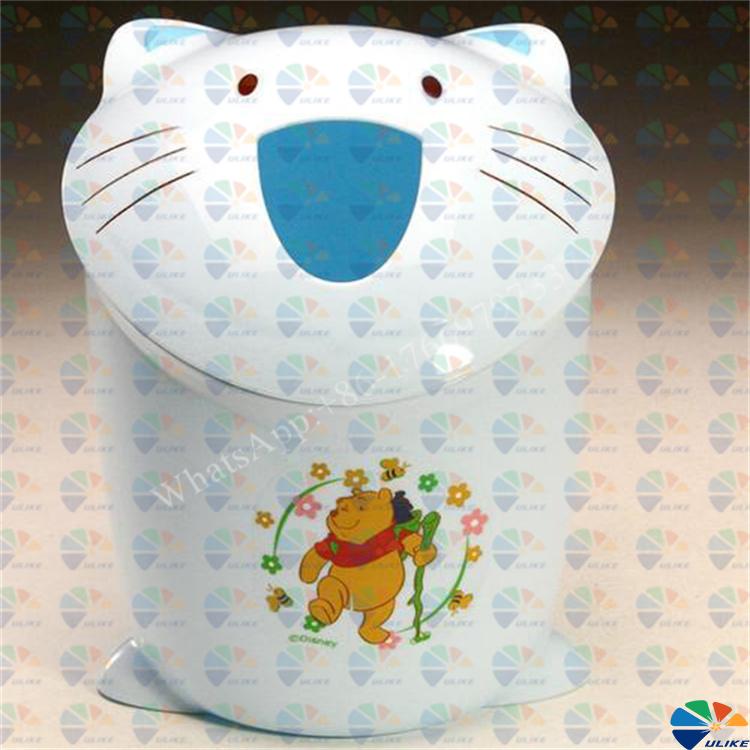Which products can be thermally transferred?
1-Which products can be thermally transferred?
Thermal transfer technology is a special printing technology. It is a popular surface printing method in recent years. It is suitable for transfer of various materials, such as plastics (ABS, AS, PC, PP, PE, PET, PVC, EVA), glass, leather, metal after painting, wood after painting and other regular products.
Which products can be thermally transferred?
It can be applied to children's toys, student stationery, office supplies, women's cosmetics, leather wallets, wood products, food packaging, gifts and other aspects.
2-Which products are not suitable for thermal transfer?
Textile bags, T-shirts, silicone, ceramics, printed products with too rough surfaces, and some irregular substrates are also not suitable for thermal transfer. If you can't judge whether your product can be thermally transferred, you can attach product information and pictures to consult customer service.
3-What equipment is needed for thermal transfer?
1.
Thermal transfer machine
The thermal transfer machine is the main equipment for processing operations. If there is no thermal transfer machine, the thermal transfer operation cannot be completed. During the processing, it is necessary to clean the surface of the product first, adjust the appropriate pressure and temperature according to the product properties, and press it lightly to print the film on the designated position, so that it can be easily completed.
2. Clamp
Due to the many restrictions of thermal transfer (such as transfer area and substrate shape, etc.), objects of different areas and shapes will use specific fixing tools-clamps to fix the product to ensure that the pattern is accurately overprinted at the designated position.
3. Rubber Roller
The rubber roller is an indispensable consumable in the
thermal transfer process. It can be used continuously at high temperatures and has good thermal conductivity and non-adhesiveness. It is an ideal choice for transfer decoration of cylindrical peripheries and large flat or curved surfaces.
The outer layer of the rubber roller is silicone, which is soft and slightly elastic. It can print a variety of plastic products with ideal results. The rubber roller has multiple specifications of hardness. The higher the hardness, the better. It should be based on the product properties. Most products use 75° rubber rollers because they have moderate elasticity and softness.
![af]() Afrikaans
Afrikaans![sq]() Albanian
Albanian![am]() Amharic
Amharic![ar]() Arabic
Arabic![fr]() French
French![es]() Spanish
Spanish![ru]() Russian
Russian![de]() German
German![hy]() Armenian
Armenian![it]() Italian
Italian![ja]() Japanese
Japanese![ko]() Korean
Korean![pt]() Portuguese
Portuguese![hi]() Hindi
Hindi![az]() Azerbaijani
Azerbaijani![ro]() Romanian
Romanian![pl]() Polish
Polish![th]() Thai
Thai![el]() Greek
Greek![eu]() Basque
Basque![en]() English
English![zh-CN]() Chinese (Simplified)
Chinese (Simplified)![zh-TW]() Chinese (Traditional)
Chinese (Traditional)![be]() Belarusian
Belarusian![bn]() Bengali
Bengali![bs]() Bosnian
Bosnian![bg]() Bulgarian
Bulgarian![ca]() Catalan
Catalan![ceb]() Cebuano
Cebuano![ny]() Chichewa
Chichewa![co]() Corsican
Corsican![hr]() Croatian
Croatian![cs]() Czech
Czech![da]() Danish
Danish![nl]() Dutch
Dutch![eo]() Esperanto
Esperanto![et]() Estonian
Estonian![tl]() Filipino
Filipino![fi]() Finnish
Finnish![fy]() Frisian
Frisian![gl]() Galician
Galician![ka]() Georgian
Georgian![gu]() Gujarati
Gujarati![ht]() Haitian Creole
Haitian Creole![ha]() Hausa
Hausa![haw]() Hawaiian
Hawaiian![iw]() Hebrew
Hebrew![hmn]() Hmong
Hmong![hu]() Hungarian
Hungarian![is]() Icelandic
Icelandic![ig]() Igbo
Igbo![id]() Indonesian
Indonesian![ga]() Irish
Irish![jw]() Javanese
Javanese![kn]() Kannada
Kannada![kk]() Kazakh
Kazakh![km]() Khmer
Khmer![ku]() Kurdish (Kurmanji)
Kurdish (Kurmanji)![ky]() Kyrgyz
Kyrgyz![lo]() Lao
Lao![la]() Latin
Latin![lv]() Latvian
Latvian![lt]() Lithuanian
Lithuanian![lb]() Luxembourgish
Luxembourgish![mk]() Macedonian
Macedonian![mg]() Malagasy
Malagasy![ms]() Malay
Malay![ml]() Malayalam
Malayalam![mt]() Maltese
Maltese![mi]() Maori
Maori![mr]() Marathi
Marathi![mn]() Mongolian
Mongolian![my]() Myanmar (Burmese)
Myanmar (Burmese)![ne]() Nepali
Nepali![no]() Norwegian
Norwegian![ps]() Pashto
Pashto![fa]() Persian
Persian![pa]() Punjabi
Punjabi![sm]() Samoan
Samoan![gd]() Scottish Gaelic
Scottish Gaelic![sr]() Serbian
Serbian![st]() Sesotho
Sesotho![sn]() Shona
Shona![sd]() Sindhi
Sindhi![si]() Sinhala
Sinhala![sk]() Slovak
Slovak![sl]() Slovenian
Slovenian![so]() Somali
Somali![su]() Sudanese
Sudanese![sw]() Swahili
Swahili![sv]() Swedish
Swedish![tg]() Tajik
Tajik![ta]() Tamil
Tamil![te]() Telugu
Telugu![tr]() Turkish
Turkish![uk]() Ukrainian
Ukrainian![ur]() Urdu
Urdu![uz]() Uzbek
Uzbek![vi]() Vietnamese
Vietnamese![cy]() Welsh
Welsh![xh]() Xhosa
Xhosa![yi]() Yiddish
Yiddish![yo]() Yoruba
Yoruba![zu]() Zulu
Zulu


